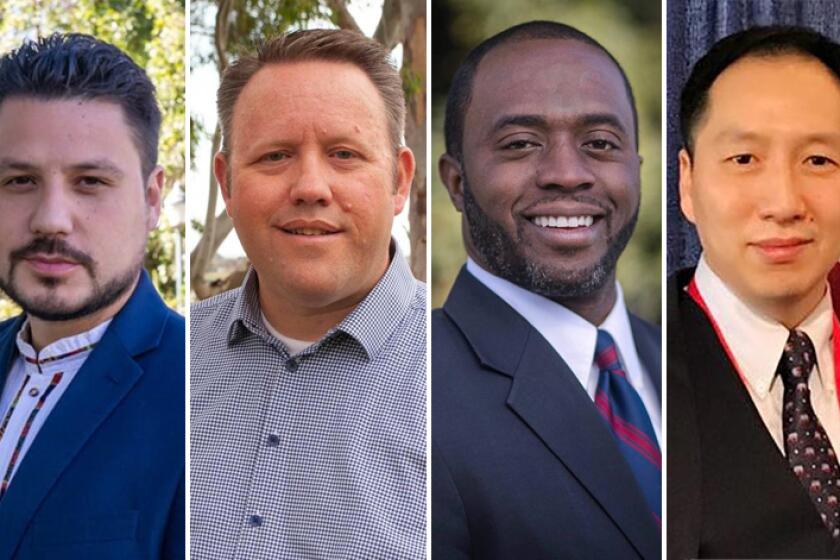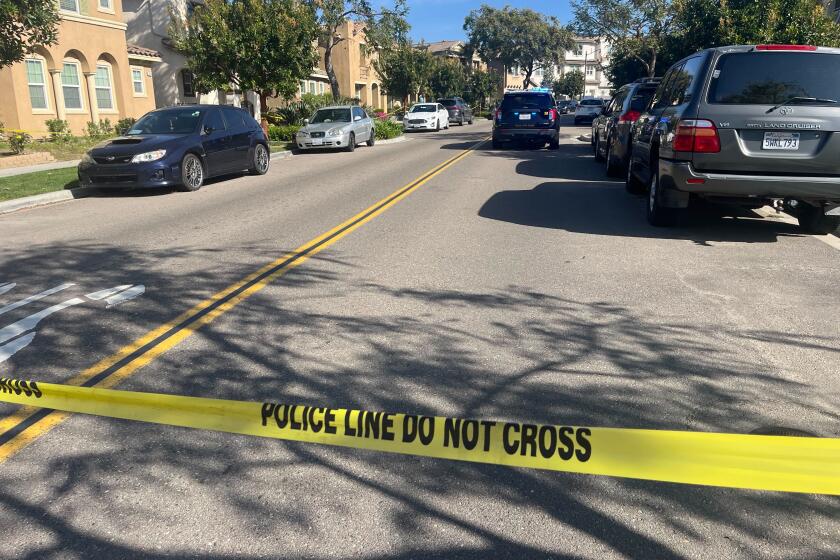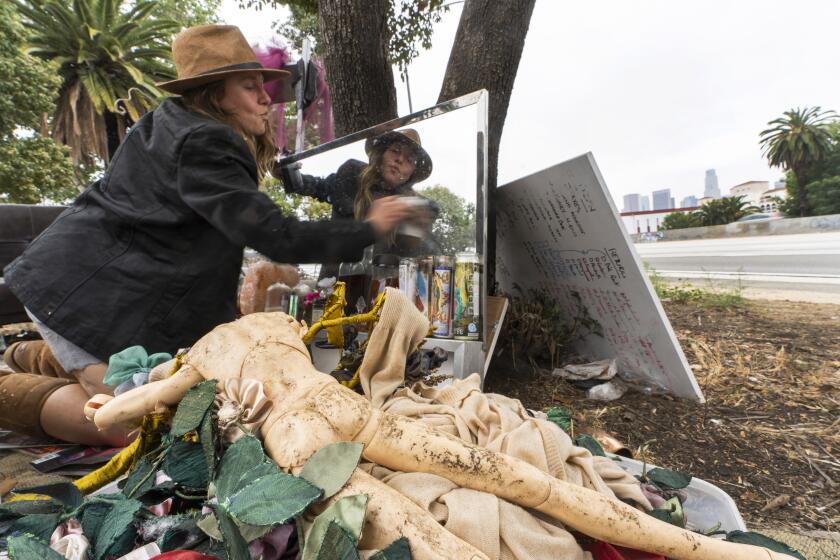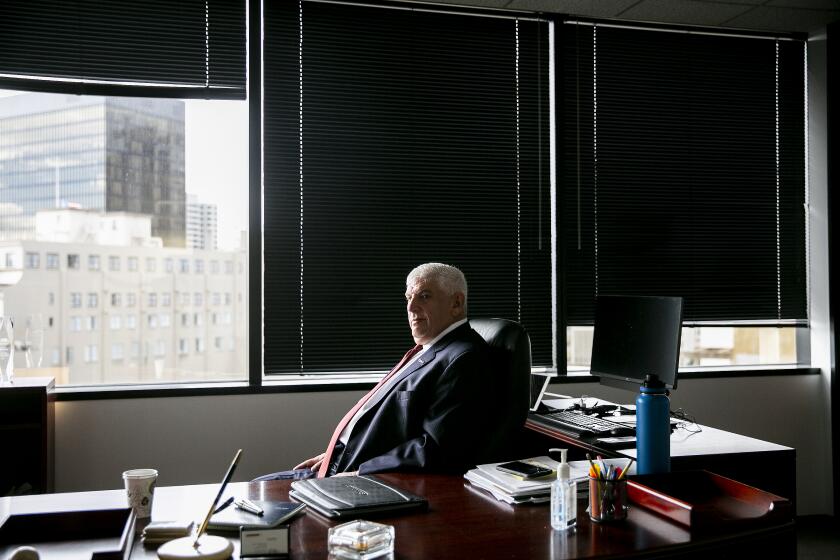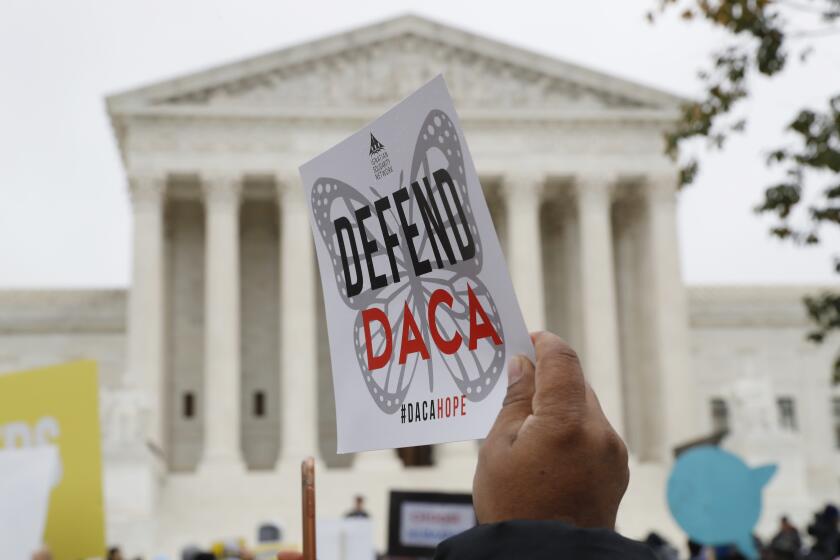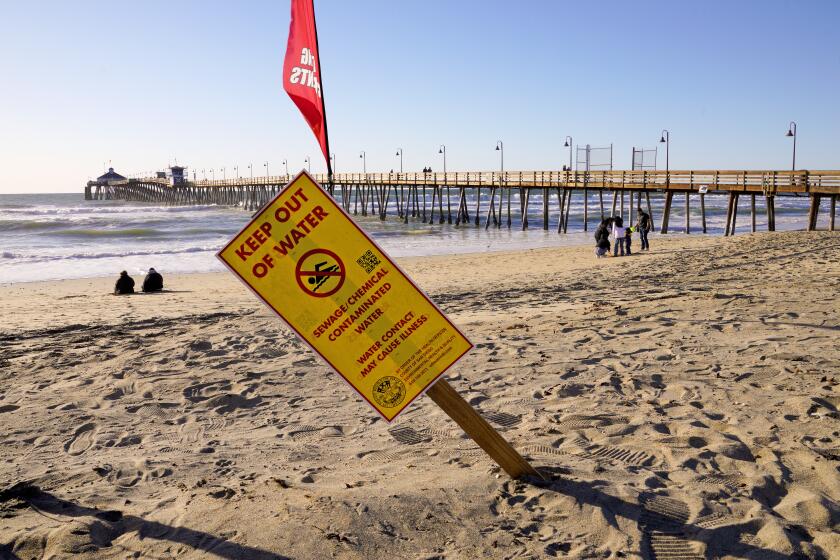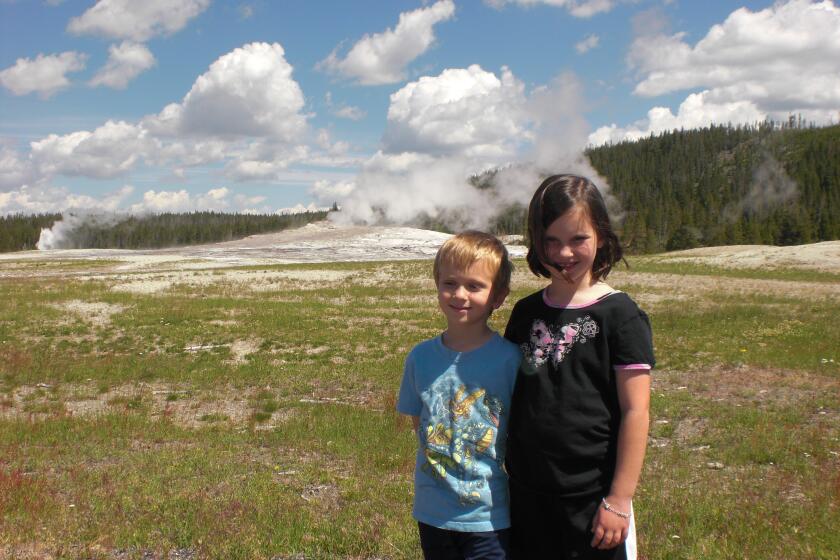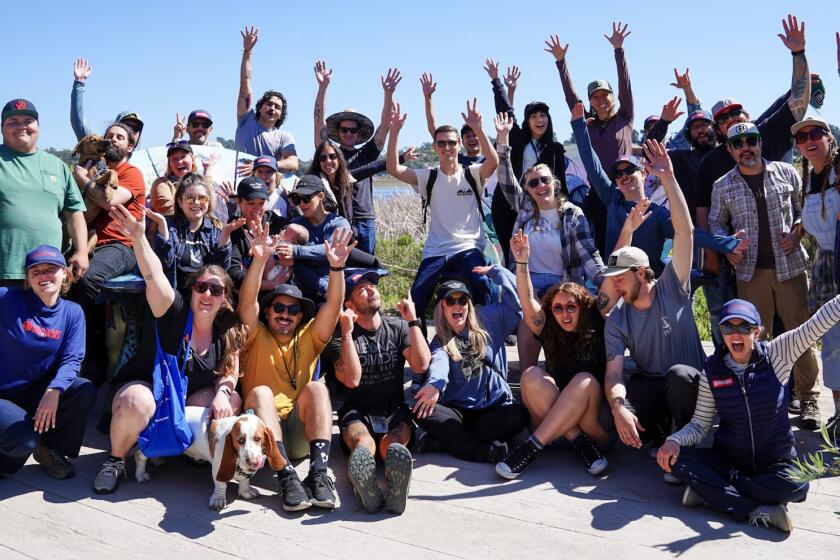2022 election: Q&A with Tony Thurmond, California superintendent of public instruction candidate

There are seven candidates for California superintendent of public instruction on the June 7 ballot. Incumbent Tony Thurmond has raised $1.5 million for his re-election campaign, while three challengers have each raised tens of thousands of dollars for theirs. They are teacher/trustee Marco Amaral, education policy executive Lance Christensen and software architect/father George Yang. The San Diego Union-Tribune Editorial Board sent these four candidates a 11-question survey and is publishing their answers here.
If you have comments or questions about the election or any of the candidates after reading this interview, please email Editorial and Opinion Director Matthew T. Hall at matthew.hall@sduniontribune.com.
Below are Tony Thurmond’s responses and a link to other responses.
Q: What in your background makes you the best candidate for this job?
A: I spent over a decade working in schools running after-school and enrichment programs, leading school-based mental health and mentoring programs, and teaching life skills and civics.
In 15 years as an elected official, I have led countless efforts that have resulted in critical resources for California schools, including universal preschool, universal meals, universal broadband programs and efforts to recruit and retain more teachers and counselors for our schools.
During the pandemic, I helped our schools serve 900 million meals and secure 1 million computers and low-cost internet for students in need and free rapid COVID-19 tests and personal protective equipment so our California schools could reopen and stay open for in-person instruction.
As we bounce back from the pandemic, I am leading a plan that includes recruiting 10,000 counselors to help students heal, providing 1 million books to families in need, ensuring students learn to read by third grade, and providing students with the chance to learn a second language so they can prepare for the jobs of tomorrow.
My experience shaped my passion for serving California schools as a parent of public school students and as a former student who relied on the free lunch program, public assistance and a great public education to overcome poverty after losing my only parent to cancer at the age of 6. My educators kept the promise of education for me, and I intend to deliver on the same promise for all of California’s students.
Marco Amaral, Lance Christensen, Tony Thurmond and George Yang are running for superintendent of public instruction in California
Q: Explain how you saw your role and how you led during the pandemic and do you think it was sufficient in light of criticism you didn’t do enough? If you had it to do over again, what would you do differently?
A: When COVID-19 disrupted our school system and unveiled a major digital divide, I worked to ensure all students would have the necessary tools to stay connected to their educators, counselors and school staff. Together with county superintendents, I made sure school districts had what they needed to transition to remote education, including delivering 900 million meals to public school students across California. In addition, we secured over 1 million computers for students, helped secure $6 billion to get high-speed internet access to all kids across the state, and pushed service providers to supply low-cost, high-speed internet to students.
During the pandemic, I led the way for California’s public schools to reopen safely. I made 5 million COVID-19 rapid testing kits available at no cost to the school districts. I administered an additional $5.2 billion for COVID-19 school relief that provided everything from computers to mental health counseling to personal protective equipment so that students could get back to learning safely.
Q: Awareness of California’s persistent achievement gap and concerns about student and teacher mental health have been heightened during the pandemic. What, specifically, would you do to address this?
A: There is no question that the pandemic unveiled tremendous mental trauma and widened the achievement gap in the last few years. California will need to step up and do more for its children to heal and get back on track for academic success. I am committed to retaining 15,000 teachers to mitigate the learning loss incurred during the pandemic. In addition, I am launching an effort to train and hire 10,000 new mental health clinicians by offering $25,000 in scholarships to those who want to enter the counseling field and commit to working in schools in high-need communities, especially in rural areas.
As our schools bounce back from the pandemic, I am working to help students build skills that will help them recover from learning loss and thrive academically. This effort includes providing 1 million books to families in need and ensuring students learn to read by third grade. Moreover, I will be providing students with the chance to learn a second language, computer science, civics education and paid internships for students in career technical education so they can prepare for the jobs of tomorrow.
Q: California is facing a teacher shortage, which was only made worse during the pandemic. What is your specific plan to address this?
A: I am leading an effort to provide $500 million in scholarships to those who want to become teachers, and providing training and professional development to help us keep 15,000 new teachers in our classrooms.
I am also working with school leaders across the state to help identify strategies for improving compensation, training and recruitment strategies that will allow us to retain more teachers and classified staff.
I have led programs to fund affordable housing so educators can continue to live in the communities where they work and continue to build on these efforts. I am also helping to recruit thousands of college students to serve as tutors and mentors in our schools, and I am helping to create a pathway for these tutors and mentors to become educators.
Q: In 2018, you told The San Diego Union-Tribune Editorial Board that Local Control Funding Formula (LCFF) money that is supposed to directly help English-language learners, foster children and students from poor families should not be used for employee salaries. Did you try to address your LCFF concerns? Is LCFF money being used as was promised when it was enacted in 2013?
A: I have worked to provide accountability in ensuring that LCFF funds are being used for the students it intended to serve, especially foster youth and other disadvantaged students.
I have made rulings to cite districts that have used LCFF funds that fall outside the intended use of LCFF.
I am also working to establish a portal that districts will use to provide complete transparency on how LCFF funds are being expended.
Q: State public school enrollment is plunging. How do California school districts adapt to this? Should systemic school closures and layoffs be considered? What role do charter schools or alternative education play?
A: California schools are experiencing a difficult transition period. Although enrollment is plunging, there are a number of factors for such a trend, including the effects of the pandemic. To reverse those trends, I am supporting two pieces of legislation: 1) to increase the base of LCFF dollars to $3 billion, going to offset declining enrollment in both traditional public schools and public charter schools, and 2) to shift the LCFF’s model from basing the funding upon average daily attendance numbers to basing the funding upon enrollment numbers.
I am working with public schools to help them find ways to attract parents back to them. My strategy to do so includes a push I am leading to dramatically broaden the number of dual language immersion programs in our state.
I have also built programs to help our schools hear California parents and to help to restore their trust that our schools will listen to parents, recognize the sacrifices they made and honor parents as partners in education. This effort includes establishing the state’s first-ever Parent Advisory Council that will advise me, the governor, the Legislature and school leaders on matters related to education.
Q: Part of the plunge in enrollment is due to the public school system simply losing its appeal for those with other options. How would you try to improve the desirability and effectiveness of California’s public schools?
A: As Californians, we have the world’s technology capital in our backyard; California’s public schools should reflect the innovation and culture that is part of our own state’s identity. I am committed to increasing career pathways programs for students who want to pursue careers in science, technology, engineering and mathematics (STEM), offering alternatives to traditional paths to pursuing higher education.
Q: There is fresh debate about student assessment and grades. What is your philosophy on student performance and how should the state best determine if students are ready to graduate?
A: Testing, assessment and accountability play an important role in our schools. We use assessment to measure where students are in relation to their peers and to identify ways that we can close learning gaps.
But I do believe that our kids are more than a test score, and we must continue to build ways to build assessment strategies that recognize the proficiency of our students in any given subject but also identify where students are in their social development, their ability to engage in critical thinking, and their ability to see the importance of civic and community engagement.
I will continue to work with educators to ensure that we provide students with an education that provides them with proficiency in Common Core subjects and allows them to apply their knowledge to the real world in practical ways that prepare them for the jobs of the future.
I will work with our schools to ensure that our students have access to rigor and education that includes important topics like science, engineering, arts and math.
Q: What should the relationship between schools and law enforcement look like?
A: Over the years, I have worked with great school resource officers who have been provided with training on how to work in school environments.
Unfortunately, many schools use law enforcement officers to serve as the dean of students or disciplinarian of students and often send officers to schools who have not had the training to be school resource officers. This practice is harmful to students and a misuse of police resources.
I am working to establish a de-escalation specialist program where people are trained in de-escalation, restorative justice and mediation and can help address student behaviors at school. This program will allow us to then work with law enforcement when serious issues or critical needs are occurring at schools (guns or bomb threats on campus, etc.) where a law enforcement presence is needed to keep everyone safe.
Q: What would be another top priority for you, other than the ones you have discussed above?
A: In my next term, I want to expand the STEM and computer science education curriculum for K-12 schools, create more arts programs and increase funding for sports, fitness and physical education for California schools, and advocate for more vocational training programs for California students.
Q: Why should voters choose you over your opponents?
A: If the past few years have been any indication, voters want someone in office who knows how to do the job. I am the only candidate who knows how to do this job. During the pandemic, I kept California students and teachers safe, bridged the digital divide, and delivered record investments in early childhood and bilingual programs.
I will ensure universal child care and meal programs will be a reality in California and increase funding for technological career pathways programs. In the next four years, I am committed to retaining 15,000 teachers and hiring 10,000 new mental clinicians in building California schools to become strong incubators of care, learning and innovation after a generational crisis.
Get Weekend Opinion on Sundays and Reader Opinion on Mondays
Editorials, commentary and more delivered Sunday morning, and Reader Reaction on Mondays.
You may occasionally receive promotional content from the San Diego Union-Tribune.
